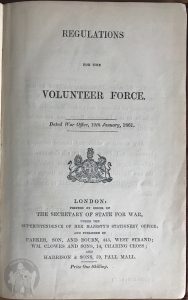You are here: Home > British Military > Volunteer Force
Written by: David Minshall
The British Volunteer Rifle has a keen interest amongst collectors and shooters of historical firearms. One oft repeated observation is that Volunteers had to purchase their own rifle. This can be misleading and is only correct for the earliest months of the establishment of the Volunteer Force in 1859. Through the year there were three War Office circulars offering to equip a Corps to the extent of 25% of its arms, then 50% and in December 1859, 100% on the effective strength of the corps.
The Circular of 13 July 1859 gave some assistance to the Volunteers by offering, on application, to furnish every Rifle Corps with (long) Enfield rifles (i.e. the Pattern 1853 Rifle Musket) to the extent of 25 per cent. of the effective volunteers. In October an additional 25 per cent. on the effective strength of the corps was made available, raising the aggregate issue to 50 per cent. A Circular of 20 December 1859 addressed plans to make available after 1 January 1860 “an additional supply of long Enfield Rifles (pattern 1853), to the extent of 50 per cent. on the effective strength of the corps.” This supply raised the aggregate issue to 100 per cent. on the effective strength of the force.

The Regulations for the Volunteer Force, dated 19 January 1861, superseded previously published Circulars and Orders relative to the Volunteer Force. Clause 102 declared that “Every Volunteer Corps is supplied gratuitously with Arms from the Government Stores, to the full number of its Enrolled Members, if required.” For rifle volunteers the arms supplied were to be “long Enfields with bayonets, or if the state of the Government Stores should permit, short Enfield Rifles, with sword bayonets, and swords for Staff-Serjeants.” The Regulations also identified arms to be supplied to Light Horse, Artillery, Engineer and Mounted Rifle Volunteers.
The early Corps of ‘gentleman’ Volunteers in the metropolitan areas, and who had equipped themselves, identified more with the Rifle Brigade than Line Infantry and favoured the Short Rifle. As the movement spread through the population and classes, there was a shift towards the Long Enfield, mirroring the Government’s increasing issue of rifles.
This subject is expanded upon in De Witt Bailey’s article on the British Volunteer Rifle 1850-1870, together with supplementary information on War Office Circulars and Volunteer Regulations, published in Research Press Digest 2023.